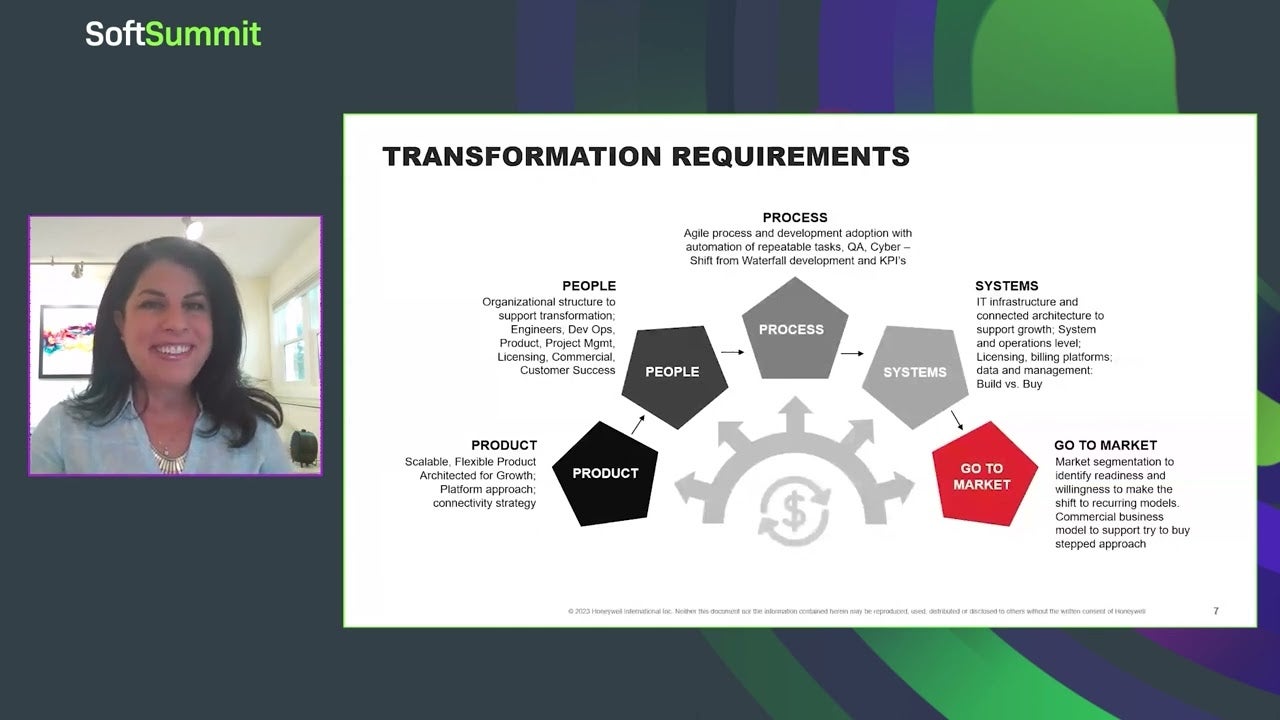Webinar
Honeywell’s Digital & Software Transformation Journey
Discover how Honeywell scaled software revenue 100% through agile, connected platforms, and recurring models.
Original Air Date: April 26, 2023
Overview
Get ready to dive into one of the most ambitious and successful software transformations in industrial tech. In this webinar, Lori Haggart, Global General Manager for Logistics Sensing at Honeywell, shares the inside story of how her team scaled software revenue by over 100% in just one year. You’ll hear how a century-old hardware powerhouse embraced agile development, built a software engineering center of excellence from the ground up, and transitioned to a recurring revenue model, all while navigating complex market forces and customer demands.
This session is packed with actionable insights for software producers: from architecting connected platforms and choosing build vs. buy strategies, to optimizing licensing, billing, and customer engagement. Learn how Honeywell leveraged best-of-breed solutions like Revenera to accelerate time-to-market and deliver measurable outcomes. Whether you're leading product, engineering, or go-to-market strategy, this webinar will equip you with proven tactics to drive growth, improve customer experience, and future-proof your business.
Recap
Key Themes and Takeaways
Understanding Honeywell’s Scale and Complexity
Honeywell’s transformation journey is framed by its size and legacy. As a Fortune 100 company with over 100,000 employees and deep roots in hardware manufacturing, the shift to software and digital solutions required navigating significant organizational and technical complexity.
Market Forces Driving Change
Customer demands for connected devices, predictive safety solutions, and sustainable technologies were major catalysts. Honeywell responded to pressures from industries like healthcare, logistics, and oil & gas by rethinking how it delivers value through digital innovation.
Starting with the Customer
The transformation began by listening to customers. Instead of selling products, Honeywell focused on solving problems—like reducing downtime and improving productivity. This mindset shift laid the foundation for a more outcome-driven approach to product development.
Five Pillars of Transformation
Honeywell anchored its strategy around five critical success factors: product, people, process, systems, and go-to-market. Each pillar was reimagined to support a scalable, flexible, and customer-centric software business model.
Build vs. Buy Decisions
As a strong engineering company, Honeywell often leaned toward building solutions internally. However, speed to market and scalability led them to partner with best-of-breed vendors like Revenera for licensing and billing platforms, accelerating their subscription capabilities.
Metrics That Matter
Honeywell shifted from backward-looking hardware metrics to forward-looking software KPIs. They tracked customer retention, trial conversion rates, MRR, churn, and NPS, using real-time dashboards to guide decisions and measure success.
Organizational and Financial Readiness
Upskilling teams, aligning leadership, and preparing finance for recurring revenue models were essential. Honeywell emphasized the importance of internal training and cross-functional collaboration to support the new business model.
Lessons Learned and What’s Next
Key takeaways included the need for brand amplification, breaking down silos, and ensuring corporate alignment. Looking ahead, Honeywell plans to expand its cloud deployment, launch self-serve portals, and grow post-sale customer success to further scale its software business.
Speakers

Lori Haggart
General Manager Logistics Sensing
Honeywell

Michael Goff
Principal Product Marketer
Revenera
Frequently Asked Questions
Transitioning from hardware to recurring revenue requires a shift in mindset, from selling products to delivering outcomes. Software producers should start by understanding customer pain points and designing connected solutions that solve real problems. Building flexible subscription models and investing in licensing and billing infrastructure are key steps. This approach not only improves customer experience but also drives predictable revenue growth.
Subscription models offer cost predictability for customers and revenue stability for vendors. They reduce upfront capital expenses and allow for scalable deployment. For software producers, subscriptions enable deeper customer insights through usage data, which can inform product development and retention strategies. Over time, this model fosters stronger customer relationships and higher lifetime value.
Key metrics include Monthly Recurring Revenue (MRR), churn rate, customer retention, trial conversion rates, and Net Promoter Score (NPS). These indicators help software producers understand customer engagement and forecast growth. Real-time dashboards and forward-looking KPIs are essential for agile decision-making and optimizing monetization strategies.
Choosing between building or buying depends on speed to market, scalability, and internal capabilities. While in-house development offers control, partnering with best-of-breed vendors can accelerate deployment and reduce risk. Software producers should evaluate the long-term cost, integration complexity, and strategic value of each option before deciding.
Customer segmentation helps identify which users are most likely to adopt new business models. By analyzing customer profiles, regions, and readiness, software producers can tailor offerings and go-to-market strategies. This targeted approach improves conversion rates and ensures that resources are focused on high-potential segments.
Improving customer experience starts with simplifying onboarding, offering flexible deployment options, and ensuring low-touch interactions. Software producers should invest in post-sale support and success teams to guide customers through the lifecycle. Real-time data and feedback loops help refine the experience and boost retention.
Software monetization often requires restructuring teams to support agile development and customer-centric delivery. Building a software engineering center of excellence, aligning sales and support functions, and training leadership are critical. These changes ensure that the organization can scale and adapt to recurring revenue models effectively.
Recurring revenue impacts cash flow, forecasting, and financial reporting. Software producers must involve finance teams early to model the business impact and align on metrics. Transparent communication and scenario planning help ensure financial stability during the transition from one-time purchases to subscriptions
Tools like Jira, Confluence, and cloud-based licensing platforms enable agile workflows and efficient product delivery. These tools foster collaboration across teams and help automate repeatable tasks like QA and billing. Software producers should choose platforms that integrate well with existing systems and support scalability.
Brand amplification is essential when shifting from traditional models to software-first strategies. Producers should communicate wins, showcase customer success stories, and invest in marketing that highlights their digital capabilities. Building credibility in the market helps attract new customers and reinforces the value of the transformation.
Resources
Webinar
AI Monetization Unlocked: Master Pricing Models and Plan for Market Success
Tuesday, January 27, 2026
Join IDC's Tiffany McCormick, Research Director, AI Monetization, Pricing Strategies, and Business Models and Revenera's Paul Bland, VP, Product Management to learn pragmatic ways to align price with value—and avoid the cost‑plus trap.
Webinar
Revenera Connect 2026: Boston
Wednesday, February 11
Webinar
6 Steps to Launching Usage-Based Pricing for SaaS and AI
Tuesday, February 17, 2026
In this webinar, Nicole Segerer, General Manager at Revenera, will share this practical 6-step framework for launching usage-based pricing in SaaS, AI, and even on-premises products.
Want to learn more?
See how Revenera's Software Monetization platform can help you take products to market fast, unlock the value of your IP and accelerate revenue growth.
